Building a Sustainable Organisation: Climeworks Case Study
VerifiedAdded on 2023/06/06
|9
|2677
|87
Case Study
AI Summary
This case study analysis examines Climeworks, a company focused on removing carbon dioxide from the atmosphere. It critically evaluates the roles and responsibilities of Christoph Gebald and Jan Wurzbacher as sustainable strategic managers, discussing the application of strategic business management tools like the Objectives and Key Results (OKR) framework and the Triple Bottom Line. The analysis explores the economic and ethical dilemmas faced by strategic leaders in balancing short-term and long-term goals. The study highlights the importance of sustainability in business operations and the challenges in implementing sustainable strategies, offering insights into the complexities of sustainable strategic management and the decisions leaders must make to achieve their goals while addressing environmental and ethical considerations.
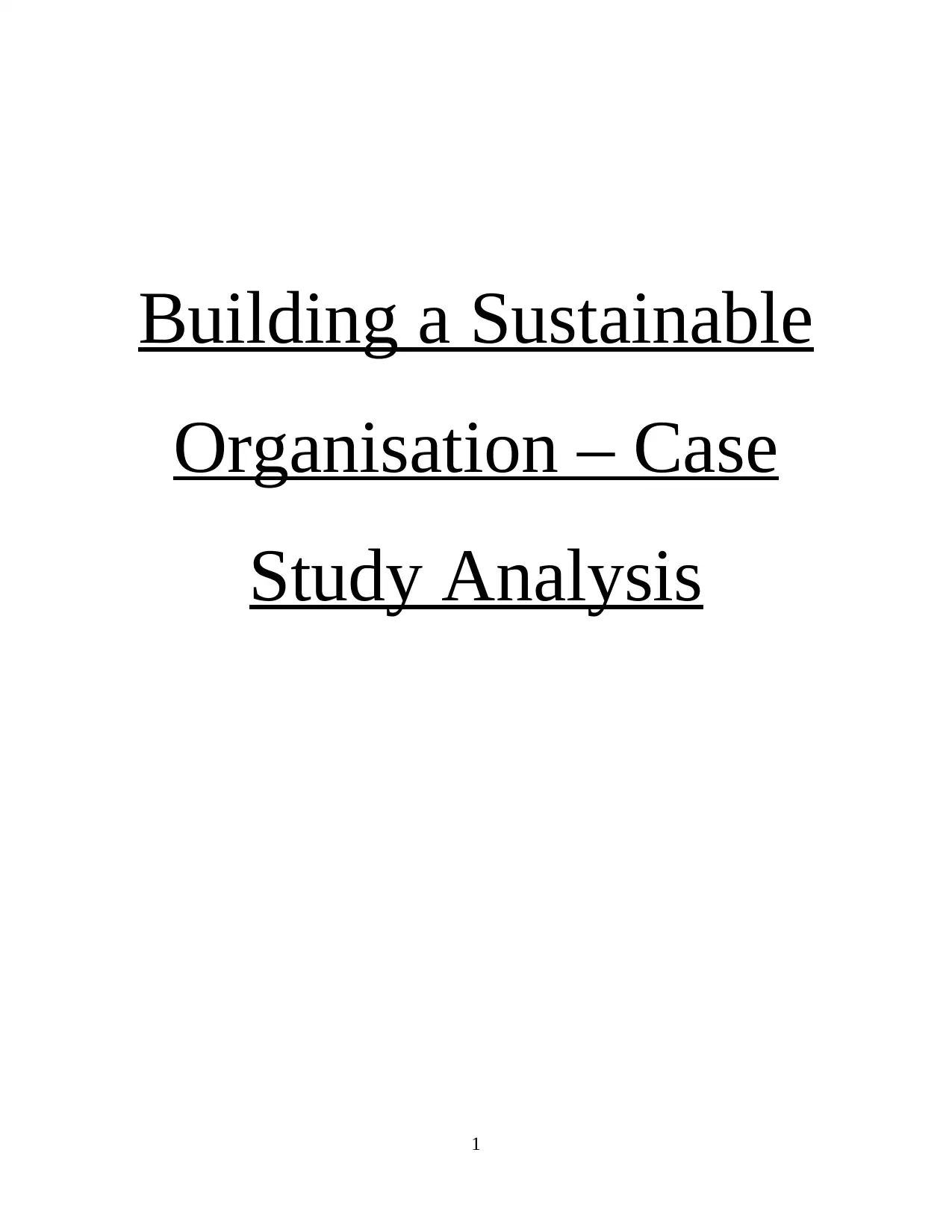
Building a Sustainable
Organisation – Case
Study Analysis
1
Organisation – Case
Study Analysis
1
Paraphrase This Document
Need a fresh take? Get an instant paraphrase of this document with our AI Paraphraser
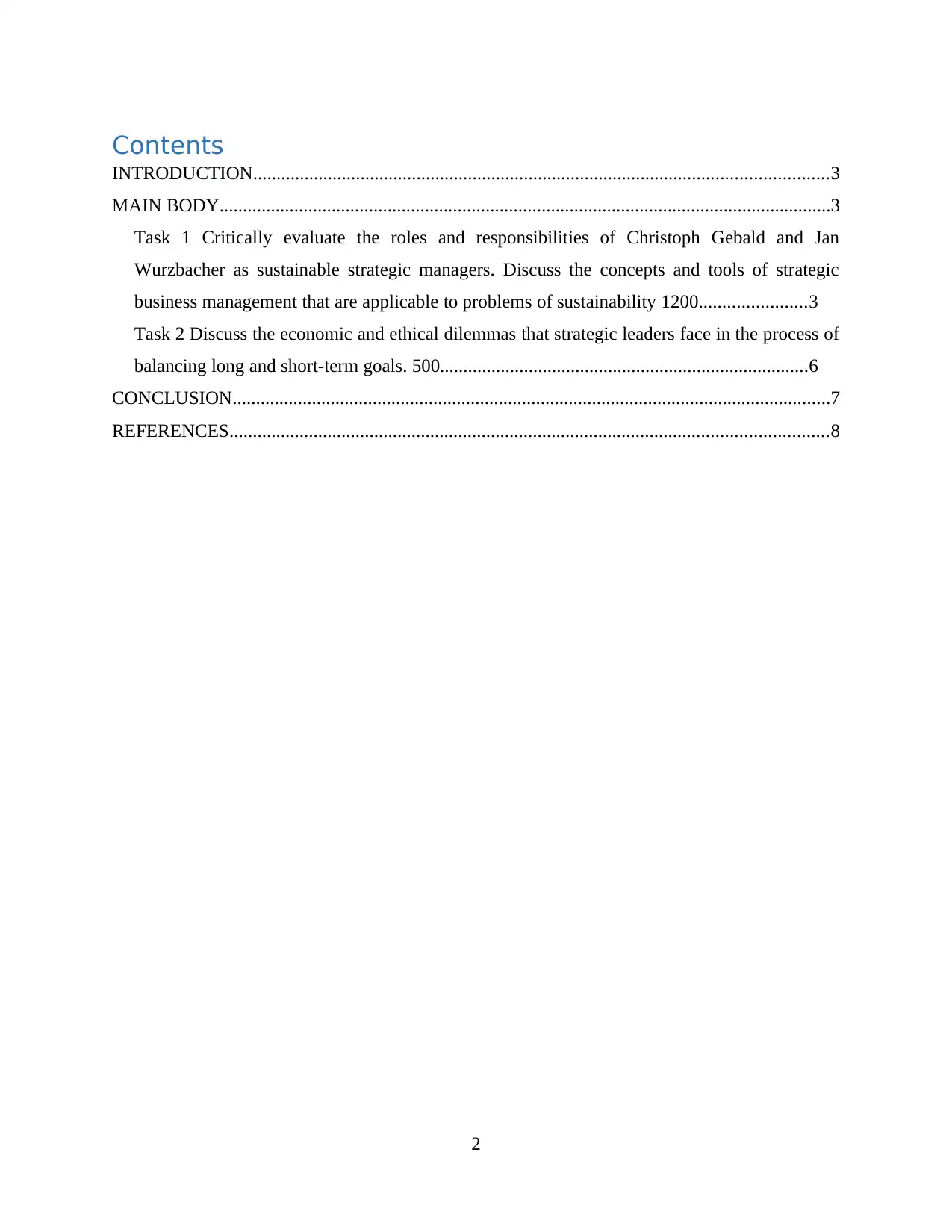
Contents
INTRODUCTION...........................................................................................................................3
MAIN BODY...................................................................................................................................3
Task 1 Critically evaluate the roles and responsibilities of Christoph Gebald and Jan
Wurzbacher as sustainable strategic managers. Discuss the concepts and tools of strategic
business management that are applicable to problems of sustainability 1200.......................3
Task 2 Discuss the economic and ethical dilemmas that strategic leaders face in the process of
balancing long and short-term goals. 500...............................................................................6
CONCLUSION................................................................................................................................7
REFERENCES................................................................................................................................8
2
INTRODUCTION...........................................................................................................................3
MAIN BODY...................................................................................................................................3
Task 1 Critically evaluate the roles and responsibilities of Christoph Gebald and Jan
Wurzbacher as sustainable strategic managers. Discuss the concepts and tools of strategic
business management that are applicable to problems of sustainability 1200.......................3
Task 2 Discuss the economic and ethical dilemmas that strategic leaders face in the process of
balancing long and short-term goals. 500...............................................................................6
CONCLUSION................................................................................................................................7
REFERENCES................................................................................................................................8
2
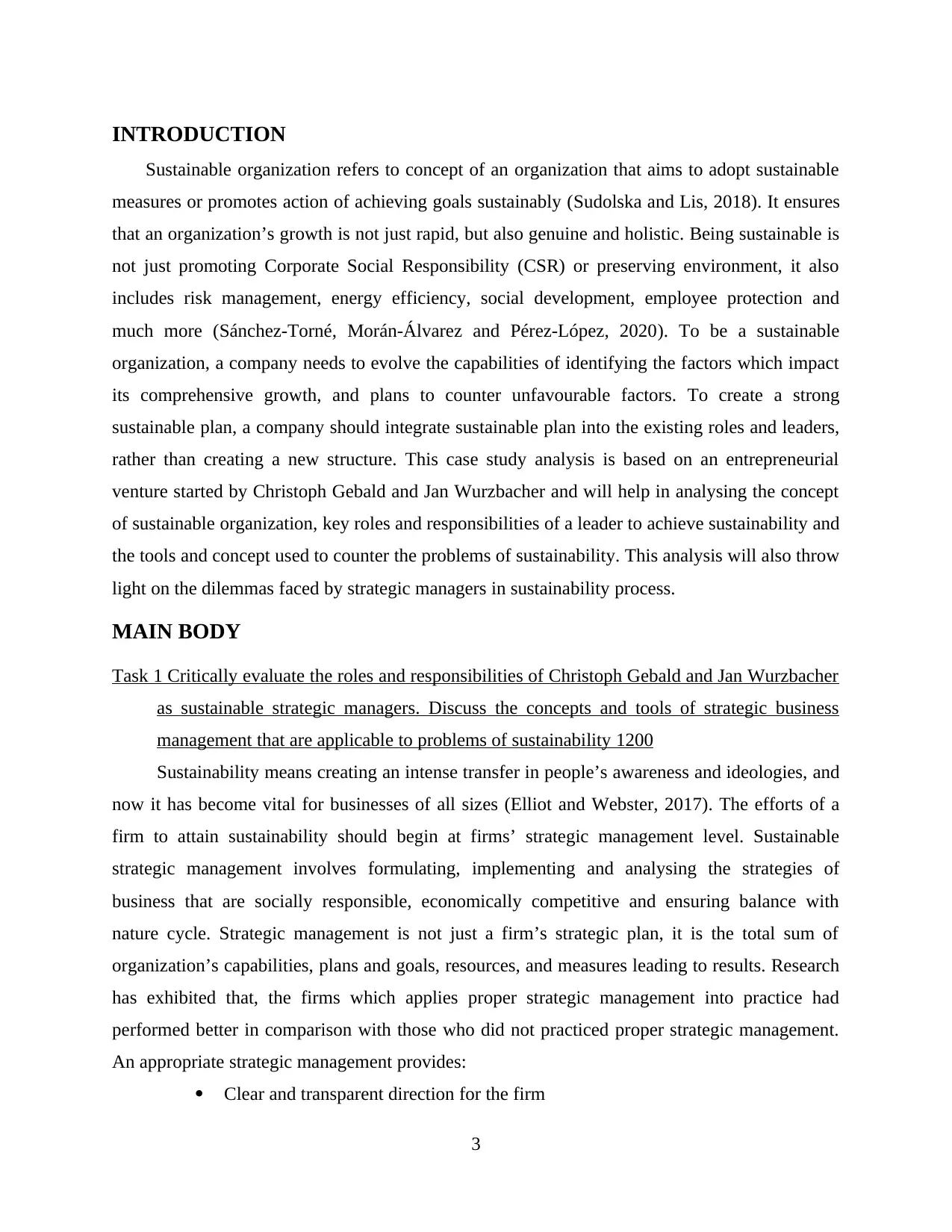
INTRODUCTION
Sustainable organization refers to concept of an organization that aims to adopt sustainable
measures or promotes action of achieving goals sustainably (Sudolska and Lis, 2018). It ensures
that an organization’s growth is not just rapid, but also genuine and holistic. Being sustainable is
not just promoting Corporate Social Responsibility (CSR) or preserving environment, it also
includes risk management, energy efficiency, social development, employee protection and
much more (Sánchez‐Torné, Morán‐Álvarez and Pérez‐López, 2020). To be a sustainable
organization, a company needs to evolve the capabilities of identifying the factors which impact
its comprehensive growth, and plans to counter unfavourable factors. To create a strong
sustainable plan, a company should integrate sustainable plan into the existing roles and leaders,
rather than creating a new structure. This case study analysis is based on an entrepreneurial
venture started by Christoph Gebald and Jan Wurzbacher and will help in analysing the concept
of sustainable organization, key roles and responsibilities of a leader to achieve sustainability and
the tools and concept used to counter the problems of sustainability. This analysis will also throw
light on the dilemmas faced by strategic managers in sustainability process.
MAIN BODY
Task 1 Critically evaluate the roles and responsibilities of Christoph Gebald and Jan Wurzbacher
as sustainable strategic managers. Discuss the concepts and tools of strategic business
management that are applicable to problems of sustainability 1200
Sustainability means creating an intense transfer in people’s awareness and ideologies, and
now it has become vital for businesses of all sizes (Elliot and Webster, 2017). The efforts of a
firm to attain sustainability should begin at firms’ strategic management level. Sustainable
strategic management involves formulating, implementing and analysing the strategies of
business that are socially responsible, economically competitive and ensuring balance with
nature cycle. Strategic management is not just a firm’s strategic plan, it is the total sum of
organization’s capabilities, plans and goals, resources, and measures leading to results. Research
has exhibited that, the firms which applies proper strategic management into practice had
performed better in comparison with those who did not practiced proper strategic management.
An appropriate strategic management provides:
Clear and transparent direction for the firm
3
Sustainable organization refers to concept of an organization that aims to adopt sustainable
measures or promotes action of achieving goals sustainably (Sudolska and Lis, 2018). It ensures
that an organization’s growth is not just rapid, but also genuine and holistic. Being sustainable is
not just promoting Corporate Social Responsibility (CSR) or preserving environment, it also
includes risk management, energy efficiency, social development, employee protection and
much more (Sánchez‐Torné, Morán‐Álvarez and Pérez‐López, 2020). To be a sustainable
organization, a company needs to evolve the capabilities of identifying the factors which impact
its comprehensive growth, and plans to counter unfavourable factors. To create a strong
sustainable plan, a company should integrate sustainable plan into the existing roles and leaders,
rather than creating a new structure. This case study analysis is based on an entrepreneurial
venture started by Christoph Gebald and Jan Wurzbacher and will help in analysing the concept
of sustainable organization, key roles and responsibilities of a leader to achieve sustainability and
the tools and concept used to counter the problems of sustainability. This analysis will also throw
light on the dilemmas faced by strategic managers in sustainability process.
MAIN BODY
Task 1 Critically evaluate the roles and responsibilities of Christoph Gebald and Jan Wurzbacher
as sustainable strategic managers. Discuss the concepts and tools of strategic business
management that are applicable to problems of sustainability 1200
Sustainability means creating an intense transfer in people’s awareness and ideologies, and
now it has become vital for businesses of all sizes (Elliot and Webster, 2017). The efforts of a
firm to attain sustainability should begin at firms’ strategic management level. Sustainable
strategic management involves formulating, implementing and analysing the strategies of
business that are socially responsible, economically competitive and ensuring balance with
nature cycle. Strategic management is not just a firm’s strategic plan, it is the total sum of
organization’s capabilities, plans and goals, resources, and measures leading to results. Research
has exhibited that, the firms which applies proper strategic management into practice had
performed better in comparison with those who did not practiced proper strategic management.
An appropriate strategic management provides:
Clear and transparent direction for the firm
3
⊘ This is a preview!⊘
Do you want full access?
Subscribe today to unlock all pages.

Trusted by 1+ million students worldwide
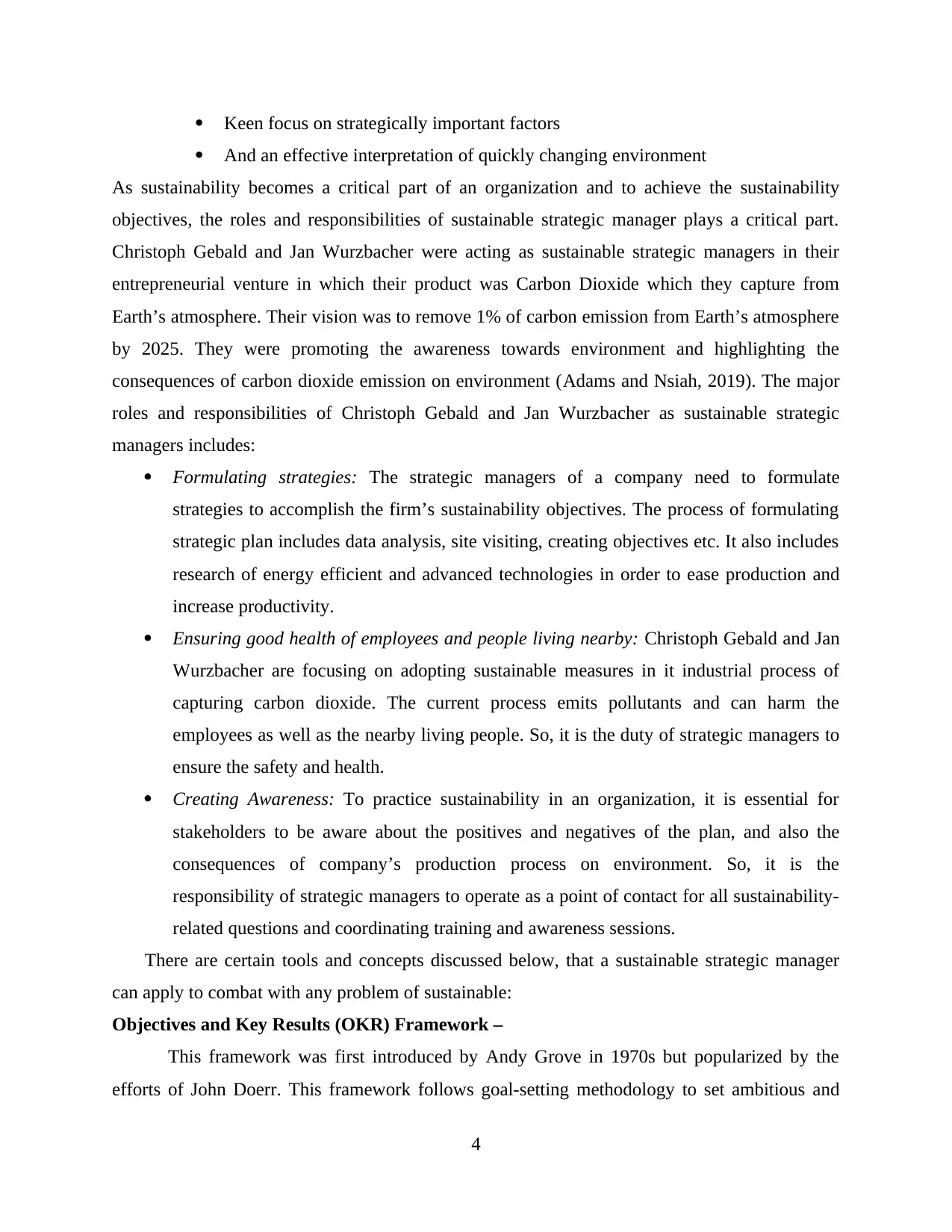
Keen focus on strategically important factors
And an effective interpretation of quickly changing environment
As sustainability becomes a critical part of an organization and to achieve the sustainability
objectives, the roles and responsibilities of sustainable strategic manager plays a critical part.
Christoph Gebald and Jan Wurzbacher were acting as sustainable strategic managers in their
entrepreneurial venture in which their product was Carbon Dioxide which they capture from
Earth’s atmosphere. Their vision was to remove 1% of carbon emission from Earth’s atmosphere
by 2025. They were promoting the awareness towards environment and highlighting the
consequences of carbon dioxide emission on environment (Adams and Nsiah, 2019). The major
roles and responsibilities of Christoph Gebald and Jan Wurzbacher as sustainable strategic
managers includes:
Formulating strategies: The strategic managers of a company need to formulate
strategies to accomplish the firm’s sustainability objectives. The process of formulating
strategic plan includes data analysis, site visiting, creating objectives etc. It also includes
research of energy efficient and advanced technologies in order to ease production and
increase productivity.
Ensuring good health of employees and people living nearby: Christoph Gebald and Jan
Wurzbacher are focusing on adopting sustainable measures in it industrial process of
capturing carbon dioxide. The current process emits pollutants and can harm the
employees as well as the nearby living people. So, it is the duty of strategic managers to
ensure the safety and health.
Creating Awareness: To practice sustainability in an organization, it is essential for
stakeholders to be aware about the positives and negatives of the plan, and also the
consequences of company’s production process on environment. So, it is the
responsibility of strategic managers to operate as a point of contact for all sustainability-
related questions and coordinating training and awareness sessions.
There are certain tools and concepts discussed below, that a sustainable strategic manager
can apply to combat with any problem of sustainable:
Objectives and Key Results (OKR) Framework –
This framework was first introduced by Andy Grove in 1970s but popularized by the
efforts of John Doerr. This framework follows goal-setting methodology to set ambitious and
4
And an effective interpretation of quickly changing environment
As sustainability becomes a critical part of an organization and to achieve the sustainability
objectives, the roles and responsibilities of sustainable strategic manager plays a critical part.
Christoph Gebald and Jan Wurzbacher were acting as sustainable strategic managers in their
entrepreneurial venture in which their product was Carbon Dioxide which they capture from
Earth’s atmosphere. Their vision was to remove 1% of carbon emission from Earth’s atmosphere
by 2025. They were promoting the awareness towards environment and highlighting the
consequences of carbon dioxide emission on environment (Adams and Nsiah, 2019). The major
roles and responsibilities of Christoph Gebald and Jan Wurzbacher as sustainable strategic
managers includes:
Formulating strategies: The strategic managers of a company need to formulate
strategies to accomplish the firm’s sustainability objectives. The process of formulating
strategic plan includes data analysis, site visiting, creating objectives etc. It also includes
research of energy efficient and advanced technologies in order to ease production and
increase productivity.
Ensuring good health of employees and people living nearby: Christoph Gebald and Jan
Wurzbacher are focusing on adopting sustainable measures in it industrial process of
capturing carbon dioxide. The current process emits pollutants and can harm the
employees as well as the nearby living people. So, it is the duty of strategic managers to
ensure the safety and health.
Creating Awareness: To practice sustainability in an organization, it is essential for
stakeholders to be aware about the positives and negatives of the plan, and also the
consequences of company’s production process on environment. So, it is the
responsibility of strategic managers to operate as a point of contact for all sustainability-
related questions and coordinating training and awareness sessions.
There are certain tools and concepts discussed below, that a sustainable strategic manager
can apply to combat with any problem of sustainable:
Objectives and Key Results (OKR) Framework –
This framework was first introduced by Andy Grove in 1970s but popularized by the
efforts of John Doerr. This framework follows goal-setting methodology to set ambitious and
4
Paraphrase This Document
Need a fresh take? Get an instant paraphrase of this document with our AI Paraphraser
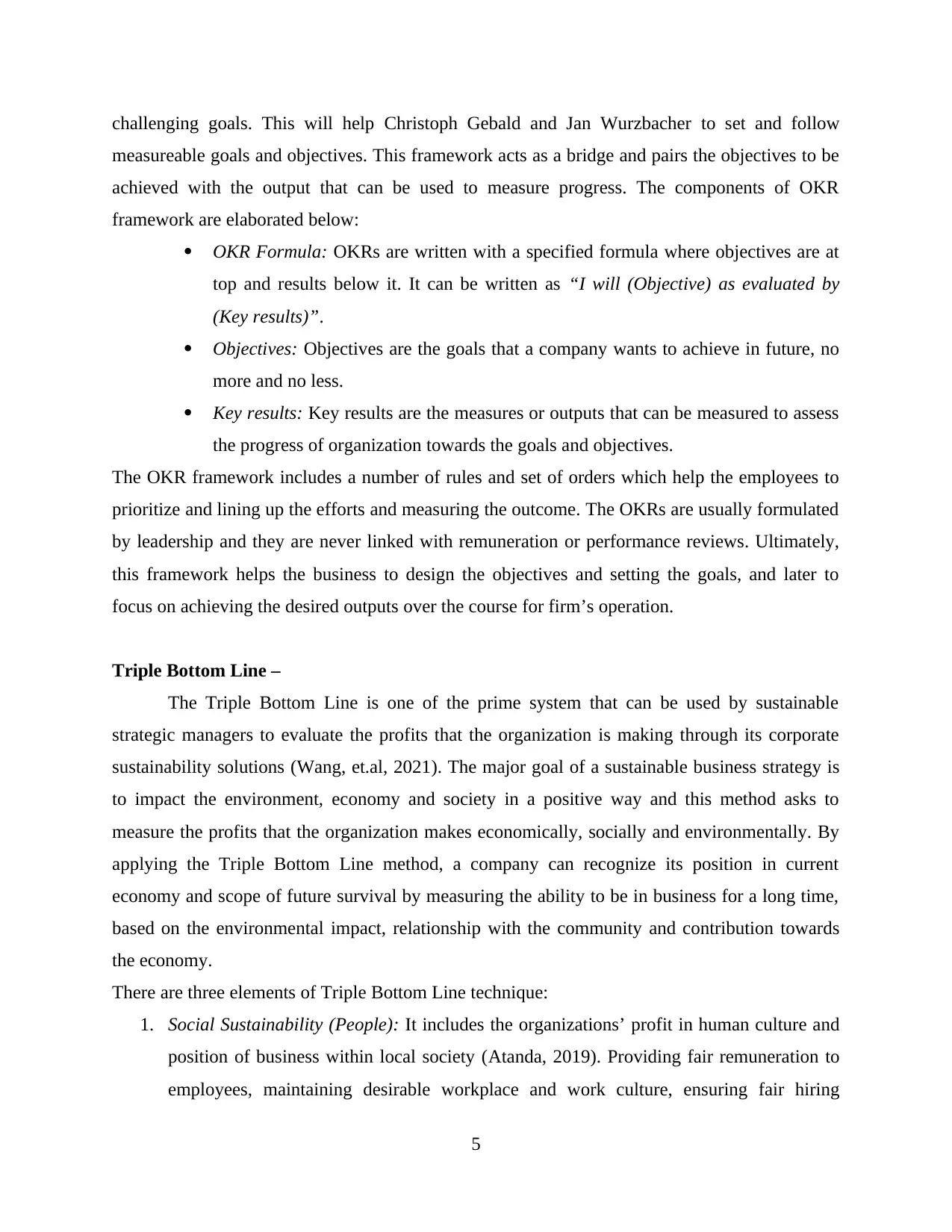
challenging goals. This will help Christoph Gebald and Jan Wurzbacher to set and follow
measureable goals and objectives. This framework acts as a bridge and pairs the objectives to be
achieved with the output that can be used to measure progress. The components of OKR
framework are elaborated below:
OKR Formula: OKRs are written with a specified formula where objectives are at
top and results below it. It can be written as “I will (Objective) as evaluated by
(Key results)”.
Objectives: Objectives are the goals that a company wants to achieve in future, no
more and no less.
Key results: Key results are the measures or outputs that can be measured to assess
the progress of organization towards the goals and objectives.
The OKR framework includes a number of rules and set of orders which help the employees to
prioritize and lining up the efforts and measuring the outcome. The OKRs are usually formulated
by leadership and they are never linked with remuneration or performance reviews. Ultimately,
this framework helps the business to design the objectives and setting the goals, and later to
focus on achieving the desired outputs over the course for firm’s operation.
Triple Bottom Line –
The Triple Bottom Line is one of the prime system that can be used by sustainable
strategic managers to evaluate the profits that the organization is making through its corporate
sustainability solutions (Wang, et.al, 2021). The major goal of a sustainable business strategy is
to impact the environment, economy and society in a positive way and this method asks to
measure the profits that the organization makes economically, socially and environmentally. By
applying the Triple Bottom Line method, a company can recognize its position in current
economy and scope of future survival by measuring the ability to be in business for a long time,
based on the environmental impact, relationship with the community and contribution towards
the economy.
There are three elements of Triple Bottom Line technique:
1. Social Sustainability (People): It includes the organizations’ profit in human culture and
position of business within local society (Atanda, 2019). Providing fair remuneration to
employees, maintaining desirable workplace and work culture, ensuring fair hiring
5
measureable goals and objectives. This framework acts as a bridge and pairs the objectives to be
achieved with the output that can be used to measure progress. The components of OKR
framework are elaborated below:
OKR Formula: OKRs are written with a specified formula where objectives are at
top and results below it. It can be written as “I will (Objective) as evaluated by
(Key results)”.
Objectives: Objectives are the goals that a company wants to achieve in future, no
more and no less.
Key results: Key results are the measures or outputs that can be measured to assess
the progress of organization towards the goals and objectives.
The OKR framework includes a number of rules and set of orders which help the employees to
prioritize and lining up the efforts and measuring the outcome. The OKRs are usually formulated
by leadership and they are never linked with remuneration or performance reviews. Ultimately,
this framework helps the business to design the objectives and setting the goals, and later to
focus on achieving the desired outputs over the course for firm’s operation.
Triple Bottom Line –
The Triple Bottom Line is one of the prime system that can be used by sustainable
strategic managers to evaluate the profits that the organization is making through its corporate
sustainability solutions (Wang, et.al, 2021). The major goal of a sustainable business strategy is
to impact the environment, economy and society in a positive way and this method asks to
measure the profits that the organization makes economically, socially and environmentally. By
applying the Triple Bottom Line method, a company can recognize its position in current
economy and scope of future survival by measuring the ability to be in business for a long time,
based on the environmental impact, relationship with the community and contribution towards
the economy.
There are three elements of Triple Bottom Line technique:
1. Social Sustainability (People): It includes the organizations’ profit in human culture and
position of business within local society (Atanda, 2019). Providing fair remuneration to
employees, maintaining desirable workplace and work culture, ensuring fair hiring
5
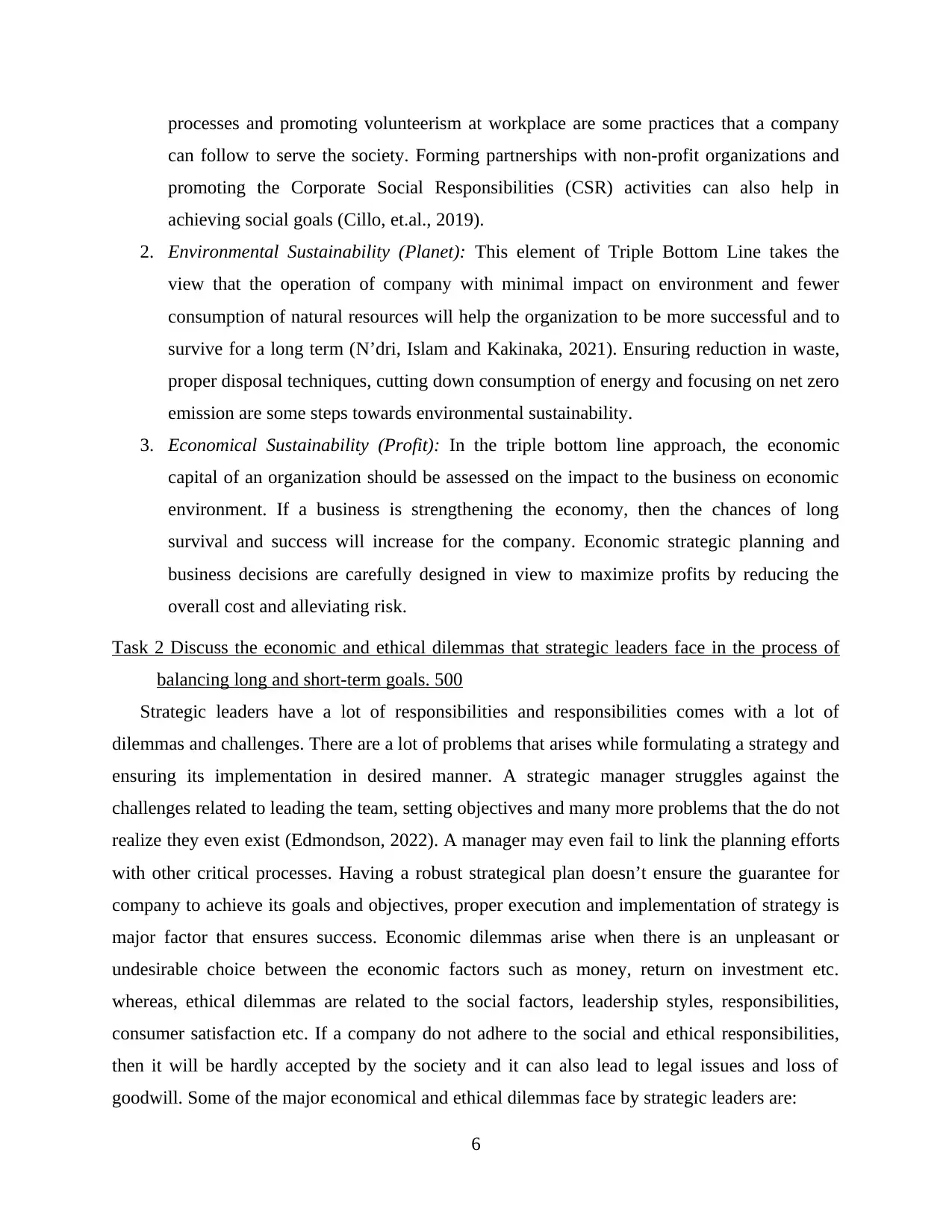
processes and promoting volunteerism at workplace are some practices that a company
can follow to serve the society. Forming partnerships with non-profit organizations and
promoting the Corporate Social Responsibilities (CSR) activities can also help in
achieving social goals (Cillo, et.al., 2019).
2. Environmental Sustainability (Planet): This element of Triple Bottom Line takes the
view that the operation of company with minimal impact on environment and fewer
consumption of natural resources will help the organization to be more successful and to
survive for a long term (N’dri, Islam and Kakinaka, 2021). Ensuring reduction in waste,
proper disposal techniques, cutting down consumption of energy and focusing on net zero
emission are some steps towards environmental sustainability.
3. Economical Sustainability (Profit): In the triple bottom line approach, the economic
capital of an organization should be assessed on the impact to the business on economic
environment. If a business is strengthening the economy, then the chances of long
survival and success will increase for the company. Economic strategic planning and
business decisions are carefully designed in view to maximize profits by reducing the
overall cost and alleviating risk.
Task 2 Discuss the economic and ethical dilemmas that strategic leaders face in the process of
balancing long and short-term goals. 500
Strategic leaders have a lot of responsibilities and responsibilities comes with a lot of
dilemmas and challenges. There are a lot of problems that arises while formulating a strategy and
ensuring its implementation in desired manner. A strategic manager struggles against the
challenges related to leading the team, setting objectives and many more problems that the do not
realize they even exist (Edmondson, 2022). A manager may even fail to link the planning efforts
with other critical processes. Having a robust strategical plan doesn’t ensure the guarantee for
company to achieve its goals and objectives, proper execution and implementation of strategy is
major factor that ensures success. Economic dilemmas arise when there is an unpleasant or
undesirable choice between the economic factors such as money, return on investment etc.
whereas, ethical dilemmas are related to the social factors, leadership styles, responsibilities,
consumer satisfaction etc. If a company do not adhere to the social and ethical responsibilities,
then it will be hardly accepted by the society and it can also lead to legal issues and loss of
goodwill. Some of the major economical and ethical dilemmas face by strategic leaders are:
6
can follow to serve the society. Forming partnerships with non-profit organizations and
promoting the Corporate Social Responsibilities (CSR) activities can also help in
achieving social goals (Cillo, et.al., 2019).
2. Environmental Sustainability (Planet): This element of Triple Bottom Line takes the
view that the operation of company with minimal impact on environment and fewer
consumption of natural resources will help the organization to be more successful and to
survive for a long term (N’dri, Islam and Kakinaka, 2021). Ensuring reduction in waste,
proper disposal techniques, cutting down consumption of energy and focusing on net zero
emission are some steps towards environmental sustainability.
3. Economical Sustainability (Profit): In the triple bottom line approach, the economic
capital of an organization should be assessed on the impact to the business on economic
environment. If a business is strengthening the economy, then the chances of long
survival and success will increase for the company. Economic strategic planning and
business decisions are carefully designed in view to maximize profits by reducing the
overall cost and alleviating risk.
Task 2 Discuss the economic and ethical dilemmas that strategic leaders face in the process of
balancing long and short-term goals. 500
Strategic leaders have a lot of responsibilities and responsibilities comes with a lot of
dilemmas and challenges. There are a lot of problems that arises while formulating a strategy and
ensuring its implementation in desired manner. A strategic manager struggles against the
challenges related to leading the team, setting objectives and many more problems that the do not
realize they even exist (Edmondson, 2022). A manager may even fail to link the planning efforts
with other critical processes. Having a robust strategical plan doesn’t ensure the guarantee for
company to achieve its goals and objectives, proper execution and implementation of strategy is
major factor that ensures success. Economic dilemmas arise when there is an unpleasant or
undesirable choice between the economic factors such as money, return on investment etc.
whereas, ethical dilemmas are related to the social factors, leadership styles, responsibilities,
consumer satisfaction etc. If a company do not adhere to the social and ethical responsibilities,
then it will be hardly accepted by the society and it can also lead to legal issues and loss of
goodwill. Some of the major economical and ethical dilemmas face by strategic leaders are:
6
⊘ This is a preview!⊘
Do you want full access?
Subscribe today to unlock all pages.

Trusted by 1+ million students worldwide
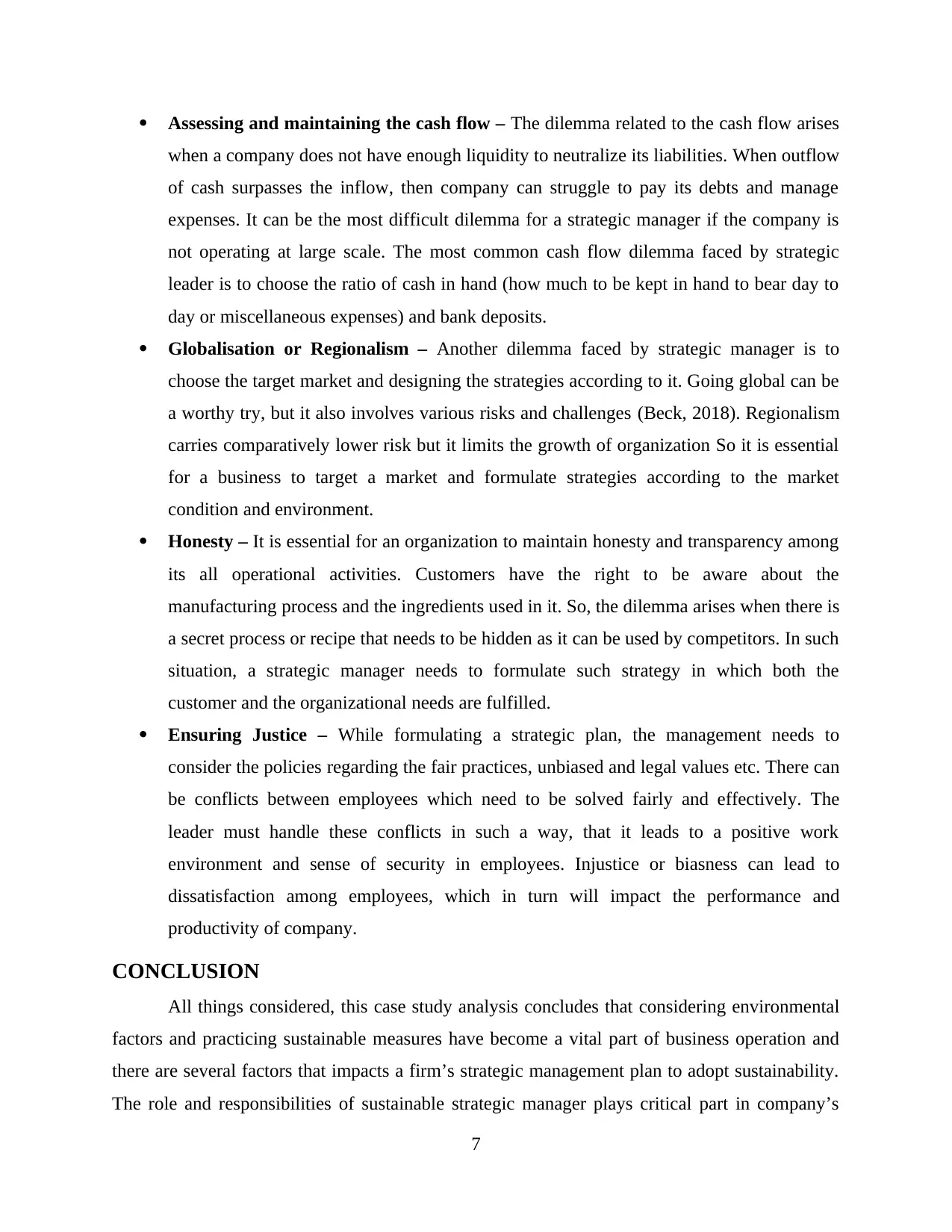
Assessing and maintaining the cash flow – The dilemma related to the cash flow arises
when a company does not have enough liquidity to neutralize its liabilities. When outflow
of cash surpasses the inflow, then company can struggle to pay its debts and manage
expenses. It can be the most difficult dilemma for a strategic manager if the company is
not operating at large scale. The most common cash flow dilemma faced by strategic
leader is to choose the ratio of cash in hand (how much to be kept in hand to bear day to
day or miscellaneous expenses) and bank deposits.
Globalisation or Regionalism – Another dilemma faced by strategic manager is to
choose the target market and designing the strategies according to it. Going global can be
a worthy try, but it also involves various risks and challenges (Beck, 2018). Regionalism
carries comparatively lower risk but it limits the growth of organization So it is essential
for a business to target a market and formulate strategies according to the market
condition and environment.
Honesty – It is essential for an organization to maintain honesty and transparency among
its all operational activities. Customers have the right to be aware about the
manufacturing process and the ingredients used in it. So, the dilemma arises when there is
a secret process or recipe that needs to be hidden as it can be used by competitors. In such
situation, a strategic manager needs to formulate such strategy in which both the
customer and the organizational needs are fulfilled.
Ensuring Justice – While formulating a strategic plan, the management needs to
consider the policies regarding the fair practices, unbiased and legal values etc. There can
be conflicts between employees which need to be solved fairly and effectively. The
leader must handle these conflicts in such a way, that it leads to a positive work
environment and sense of security in employees. Injustice or biasness can lead to
dissatisfaction among employees, which in turn will impact the performance and
productivity of company.
CONCLUSION
All things considered, this case study analysis concludes that considering environmental
factors and practicing sustainable measures have become a vital part of business operation and
there are several factors that impacts a firm’s strategic management plan to adopt sustainability.
The role and responsibilities of sustainable strategic manager plays critical part in company’s
7
when a company does not have enough liquidity to neutralize its liabilities. When outflow
of cash surpasses the inflow, then company can struggle to pay its debts and manage
expenses. It can be the most difficult dilemma for a strategic manager if the company is
not operating at large scale. The most common cash flow dilemma faced by strategic
leader is to choose the ratio of cash in hand (how much to be kept in hand to bear day to
day or miscellaneous expenses) and bank deposits.
Globalisation or Regionalism – Another dilemma faced by strategic manager is to
choose the target market and designing the strategies according to it. Going global can be
a worthy try, but it also involves various risks and challenges (Beck, 2018). Regionalism
carries comparatively lower risk but it limits the growth of organization So it is essential
for a business to target a market and formulate strategies according to the market
condition and environment.
Honesty – It is essential for an organization to maintain honesty and transparency among
its all operational activities. Customers have the right to be aware about the
manufacturing process and the ingredients used in it. So, the dilemma arises when there is
a secret process or recipe that needs to be hidden as it can be used by competitors. In such
situation, a strategic manager needs to formulate such strategy in which both the
customer and the organizational needs are fulfilled.
Ensuring Justice – While formulating a strategic plan, the management needs to
consider the policies regarding the fair practices, unbiased and legal values etc. There can
be conflicts between employees which need to be solved fairly and effectively. The
leader must handle these conflicts in such a way, that it leads to a positive work
environment and sense of security in employees. Injustice or biasness can lead to
dissatisfaction among employees, which in turn will impact the performance and
productivity of company.
CONCLUSION
All things considered, this case study analysis concludes that considering environmental
factors and practicing sustainable measures have become a vital part of business operation and
there are several factors that impacts a firm’s strategic management plan to adopt sustainability.
The role and responsibilities of sustainable strategic manager plays critical part in company’s
7
Paraphrase This Document
Need a fresh take? Get an instant paraphrase of this document with our AI Paraphraser
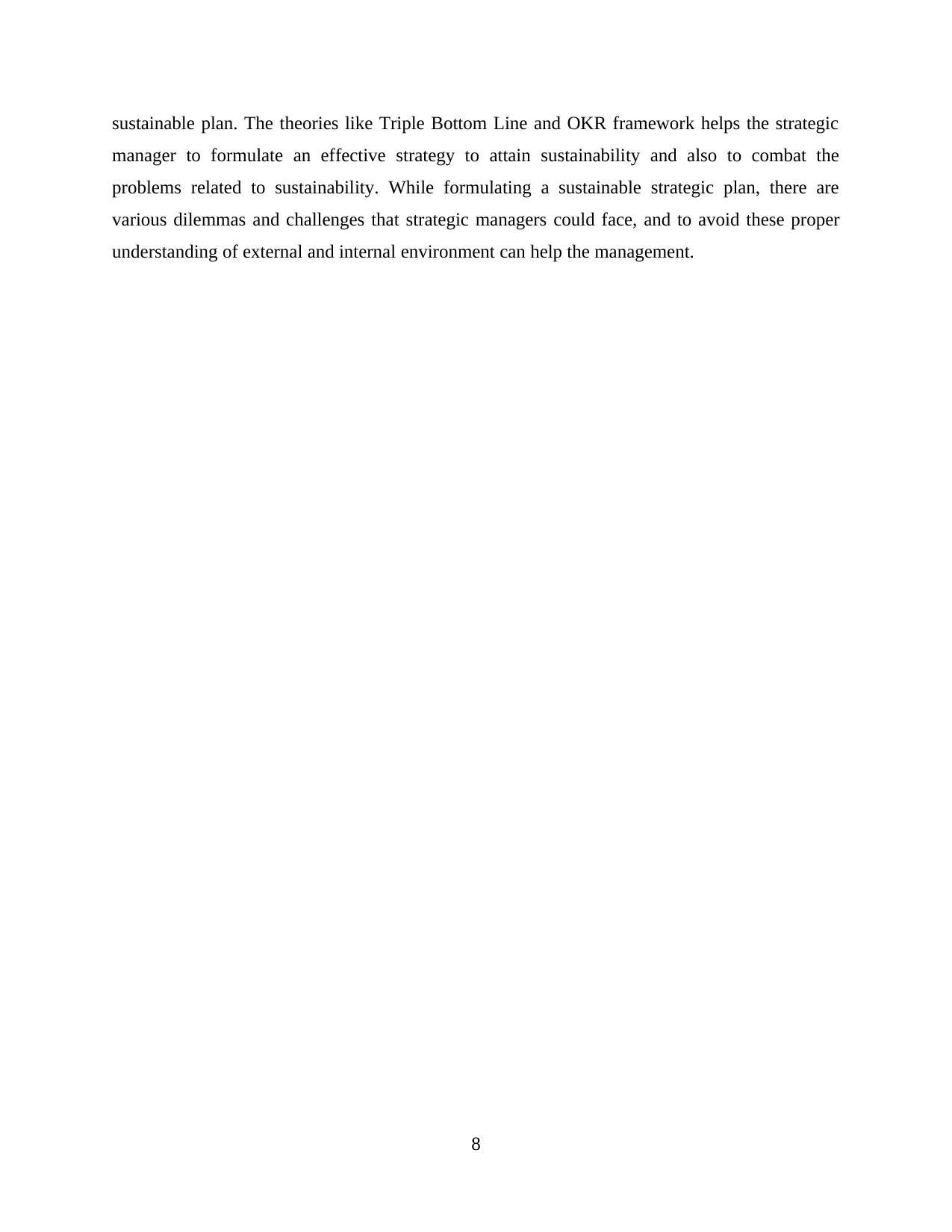
sustainable plan. The theories like Triple Bottom Line and OKR framework helps the strategic
manager to formulate an effective strategy to attain sustainability and also to combat the
problems related to sustainability. While formulating a sustainable strategic plan, there are
various dilemmas and challenges that strategic managers could face, and to avoid these proper
understanding of external and internal environment can help the management.
8
manager to formulate an effective strategy to attain sustainability and also to combat the
problems related to sustainability. While formulating a sustainable strategic plan, there are
various dilemmas and challenges that strategic managers could face, and to avoid these proper
understanding of external and internal environment can help the management.
8
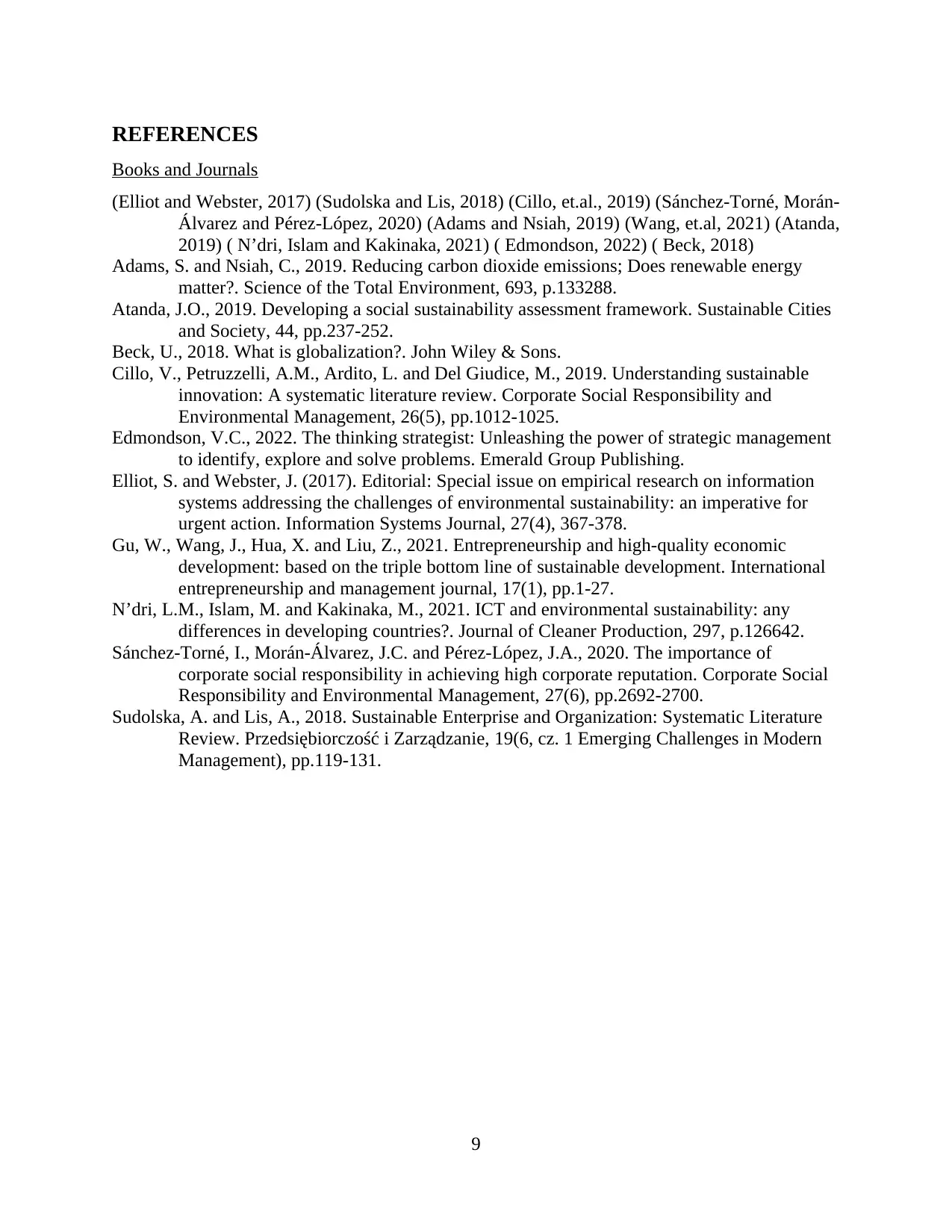
REFERENCES
Books and Journals
(Elliot and Webster, 2017) (Sudolska and Lis, 2018) (Cillo, et.al., 2019) (Sánchez‐Torné, Morán‐
Álvarez and Pérez‐López, 2020) (Adams and Nsiah, 2019) (Wang, et.al, 2021) (Atanda,
2019) ( N’dri, Islam and Kakinaka, 2021) ( Edmondson, 2022) ( Beck, 2018)
Adams, S. and Nsiah, C., 2019. Reducing carbon dioxide emissions; Does renewable energy
matter?. Science of the Total Environment, 693, p.133288.
Atanda, J.O., 2019. Developing a social sustainability assessment framework. Sustainable Cities
and Society, 44, pp.237-252.
Beck, U., 2018. What is globalization?. John Wiley & Sons.
Cillo, V., Petruzzelli, A.M., Ardito, L. and Del Giudice, M., 2019. Understanding sustainable
innovation: A systematic literature review. Corporate Social Responsibility and
Environmental Management, 26(5), pp.1012-1025.
Edmondson, V.C., 2022. The thinking strategist: Unleashing the power of strategic management
to identify, explore and solve problems. Emerald Group Publishing.
Elliot, S. and Webster, J. (2017). Editorial: Special issue on empirical research on information
systems addressing the challenges of environmental sustainability: an imperative for
urgent action. Information Systems Journal, 27(4), 367-378.
Gu, W., Wang, J., Hua, X. and Liu, Z., 2021. Entrepreneurship and high-quality economic
development: based on the triple bottom line of sustainable development. International
entrepreneurship and management journal, 17(1), pp.1-27.
N’dri, L.M., Islam, M. and Kakinaka, M., 2021. ICT and environmental sustainability: any
differences in developing countries?. Journal of Cleaner Production, 297, p.126642.
Sánchez‐Torné, I., Morán‐Álvarez, J.C. and Pérez‐López, J.A., 2020. The importance of
corporate social responsibility in achieving high corporate reputation. Corporate Social
Responsibility and Environmental Management, 27(6), pp.2692-2700.
Sudolska, A. and Lis, A., 2018. Sustainable Enterprise and Organization: Systematic Literature
Review. Przedsiębiorczość i Zarządzanie, 19(6, cz. 1 Emerging Challenges in Modern
Management), pp.119-131.
9
Books and Journals
(Elliot and Webster, 2017) (Sudolska and Lis, 2018) (Cillo, et.al., 2019) (Sánchez‐Torné, Morán‐
Álvarez and Pérez‐López, 2020) (Adams and Nsiah, 2019) (Wang, et.al, 2021) (Atanda,
2019) ( N’dri, Islam and Kakinaka, 2021) ( Edmondson, 2022) ( Beck, 2018)
Adams, S. and Nsiah, C., 2019. Reducing carbon dioxide emissions; Does renewable energy
matter?. Science of the Total Environment, 693, p.133288.
Atanda, J.O., 2019. Developing a social sustainability assessment framework. Sustainable Cities
and Society, 44, pp.237-252.
Beck, U., 2018. What is globalization?. John Wiley & Sons.
Cillo, V., Petruzzelli, A.M., Ardito, L. and Del Giudice, M., 2019. Understanding sustainable
innovation: A systematic literature review. Corporate Social Responsibility and
Environmental Management, 26(5), pp.1012-1025.
Edmondson, V.C., 2022. The thinking strategist: Unleashing the power of strategic management
to identify, explore and solve problems. Emerald Group Publishing.
Elliot, S. and Webster, J. (2017). Editorial: Special issue on empirical research on information
systems addressing the challenges of environmental sustainability: an imperative for
urgent action. Information Systems Journal, 27(4), 367-378.
Gu, W., Wang, J., Hua, X. and Liu, Z., 2021. Entrepreneurship and high-quality economic
development: based on the triple bottom line of sustainable development. International
entrepreneurship and management journal, 17(1), pp.1-27.
N’dri, L.M., Islam, M. and Kakinaka, M., 2021. ICT and environmental sustainability: any
differences in developing countries?. Journal of Cleaner Production, 297, p.126642.
Sánchez‐Torné, I., Morán‐Álvarez, J.C. and Pérez‐López, J.A., 2020. The importance of
corporate social responsibility in achieving high corporate reputation. Corporate Social
Responsibility and Environmental Management, 27(6), pp.2692-2700.
Sudolska, A. and Lis, A., 2018. Sustainable Enterprise and Organization: Systematic Literature
Review. Przedsiębiorczość i Zarządzanie, 19(6, cz. 1 Emerging Challenges in Modern
Management), pp.119-131.
9
⊘ This is a preview!⊘
Do you want full access?
Subscribe today to unlock all pages.

Trusted by 1+ million students worldwide
1 out of 9
Related Documents
Your All-in-One AI-Powered Toolkit for Academic Success.
+13062052269
info@desklib.com
Available 24*7 on WhatsApp / Email
![[object Object]](/_next/static/media/star-bottom.7253800d.svg)
Unlock your academic potential
Copyright © 2020–2025 A2Z Services. All Rights Reserved. Developed and managed by ZUCOL.

